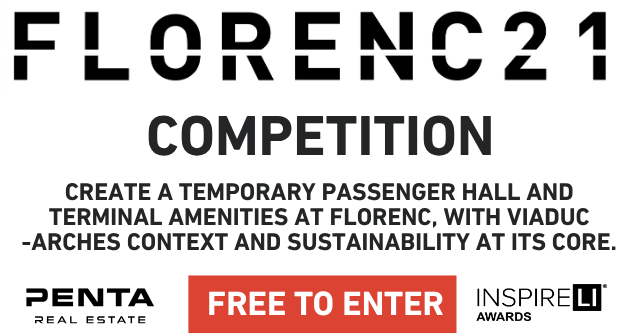EXCELBRID - obytný hybrid, Petržalka
Idea projektu
Excelbrid - obytný hybrid, v ktorom sa pevná a prázdna hmota prelínajú ako dve stránky tej istej myšlienky. Koncept sa zrodil z jednoduchého opakovania základného modulu s rozmermi 8,1 × 8,1 metra - architektonickej bunky, ktorá sa znásobuje a vytvára rytmus v organizme. Táto pravidelnosť je však zámerne narušená - mäkká línia vertikálnej záhrady pretína prísnu mriežku ako vietor kresliaci stopu po stene. Kedysi kompaktná hmota sa otvára: prízemie a horné poschodie sú odstránené, čo umožňuje dýchanie, prenikanie svetla a cirkuláciu. Budova sa mení na dynamickú štruktúru - nie je to len dom, ale pulzujúci organizmus žijúci v harmónii s rytmom mesta. Poetický príbeh "Dych medzi stenami" sa stáva kľúčom k pochopeniu celého návrhu. Je to priestorová poézia zložená nielen z formy, ale aj z absencie. Bariéra a vzdušnosť - dve protichodné sily - sa stretávajú nie ako protivníci, ale ako partneri v tanci. Bariéra definuje tvar, poskytuje bezpečnosť, ale vytvára aj tiene. Vzdušnosť reaguje prázdnotou, v ktorej sa objavuje význam. Excelbrid pretavuje túto filozofiu do architektonického jazyka: stena sa stáva rámom aj portálom, hranica sa mení na priepustný filter. Dom nie je uzavretý, ale otvorený a prívetivý - miesto, kde vietor voľne prechádza medzi stenami a zanecháva za sebou len pohyb bez odporu.
Popis projektu
Budova je umiestnená pozdĺž električkovej trate, pričom rešpektuje existujúcu dopravnú os. Na konci pozemku, v blízkosti Panónskej ulice, sa objavuje výšková veža so zmiešaným využitím ako vertikálny orientačný bod - kotviaci bod k horizontálnemu telesu hlavnej stavby. Nádvorie nie je len priestorom medzi budovami, ale zámerne navrhnutým komunitným prostredím. Nachádzajú sa tu pavilóny na oddych, športové ihriská, komunitné záhrady, detské ihriská, pingpongové stoly, miesta na sedenie a pešie chodníky lemované zeleňou - mikrokozmos, ktorý pulzuje životom svojich obyvateľov. Architektúra tohto obytného hybridu je pevná a zároveň priepustná. Na prvý pohľad sa javí ako jasne definovaná lineárna hmota, táto forma je však zámerne rozbitá. Štruktúru pretína vertikálna záhrada, ktorá do nej vstupuje ako prírodná sila a otvára fasádu svetlu, výhľadom a vzduchu. Odstránením prízemia vzniká pórovitý parter - bariéra sa dvíha na stĺpoch a umožňuje ľuďom voľný pohyb pod ňou. Funkcie ako čitárne, co-workingové priestory, multifunkčná hala, kaviarne a komunitné priestory sú umiestnené vo vzťahu k vertikálnej zeleni, čím sa vytvára dialóg medzi prírodou a funkciou, architektúrou a životom.
Technické informácie
V budove sa nachádza 298 bytových jednotiek, od jednoizbových až po štvorizbové byty. Bytovú funkciu dopĺňa 7 nájomných jednotiek, ateliéry, co-workingové priestory, centrum voľného času, denné centrum, fitnescentrum a multifunkčná hala. Dispozičné riešenie podporuje variabilitu a prirodzené svetlo, to všetko umožňuje skeletový konštrukčný systém založený na pravidelnom module 8,1 × 8,1 m, ktorý umožňuje otvorenosť a flexibilitu pre budúce zmeny. Budova stojí na jednoúrovňovej podzemnej garáži so 484 parkovacími miestami (vrátane 20 prístupných miest), 308 skladovými jednotkami a 71 vonkajšími parkovacími miestami. Materiály boli vybrané tak, aby podporovali myšlienky čistoty, nadčasovosti a ľudskej mierky. Dominantná biela omietka evokuje pokoj a neutralitu, účinne odráža svetlo a zdôrazňuje tiene vrhané vegetáciou. Sklenené zábradlia dodávajú ľahkosť, zatiaľ čo hliníkové okenné rámy odrážajú technickú presnosť. Francúzske okná spájajú vnútorné a vonkajšie priestory a oceľové konštrukcie vo vertikálnych záhradách slúžia ako konštrukčné prvky a zároveň ako opory pre rast rastlín. Materiál tu nie je len funkčný - stáva sa nositeľom významu, symbolizuje vzdušnosť, spojenie a rovnováhu medzi prírodou a architektúrou.
Hanka Cáková (Kadlicová)
Faculty of Architecture and Design STU in Bratislava
Slovakia
Architektúra
Projekt odovzdaný
30. 05. 2025Štítok
- Apartment
- Multi Unit Housing
- Private House
- Student Housing
Rady študentom


